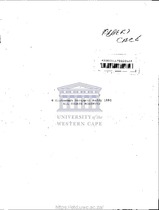| dc.description.abstract | South African society is regulated by inequality and discrimination based on race. Fundamental human rights and privileges have been extended only to a small sector of the population. The majority of South African citizens remain constrained within a context of imposed inferiority in every aspect of their lives. Inequality, entrenched in political and economic apartheid structures, is also reflected in educational provision for Black citizens. Decades of apartheid schooling have resulted in a large population of illiterate, low-literate and educationally
disadvantaged adults. Educational, political and economic discrimination all contribute to relegate Blacks to the lowest socioeconomic strata of South African society. Since numerous Blacks, particularly Africans, are restricted from effectively learning in South African schools, there is an escalating need for compensatory adult education Segregation and unequal educational provision have always characterized education in South Africa. The system of apartheid schooling was formalized by the government in 1953 when different education systems for distinct population groups were introduced. Inequalities in the structural features of apartheid schooling were evident in the discriminatory allocation of funds for public education. In 1953 government funds allocated for the education of each White child were approximately R128
(Rands), for every Indian and Coloured child R40, and for every African child R17 (a 7:1 ratio between the 'White and the African allocations). In 1976, the year of uprising by school children in Soweto, the discrepancy in allocation of educational funds had widened to a 10:1 ratio with the White allocation rising to R724, Indian to R357, Coloured to R226, and Africans to only R71 (Horrell, 1982, p. 115). At that time White, Indian and Coloured children were provided with at least ten years of free compulsory schooling. Nonetheless, the unequal
distribution of educational funds afforded White children better educational facilities and better qualified teachers than those provided for other racial groups. The deliberate system of uneven educational provision for the various population registration groups was
reinforced in the early 1960's with the progressive extension of free and compulsory schooling to Coloureds and Indians. This was done through the Coloured Person's Education Act of 1963 and the Indian Education Act of 1965. Africans, who constituted the majority of the
population and who could least afford to pay for education, were not granted free and compulsory education until almost 20 years later. Not unexpectedly, failure and drop out rates among Africans within this system were very high, with the majority of school goers not staying
beyond primary school (seven years) (Christie, 1986). Until the 1970's approximately 70 percent of Africans attending schools were attending primary school, and less than 1 percent of Africans were in Matric, the final year of formal schooling in South Africa (Christie, 1986, p. 56).In the late 1970's the White-controlled government was forced to make changes in Black education. In 1976 Black South African school children throughout the country demonstrated to the world their intolerance of the apartheid education system by rising up in protest. Continued school unrest into the 1980's not only revealed the need for an immediate and critical assessment of South African schooling, but also demanded an examination of the whole spectrum of education in South Africa. The immediate government response to these protests took the form of violent repression, student expulsions, school closures, teacher and student arrests, and the banning of 18 Black consciousness groups. Only in 1981 did the government react to the educational crisis in a more conciliatory manner with the establishment of the De Lange Commission of Inquiry. The proposals made by the Commission challenged the fundamental structures of apartheid society. The
Commission recommended a single, unitary department of education for all South Africans and a changed school structure. After dragging its feet for two years, the government officially rejected the Commission's recommendation for a unitary education system for all South Africans. | en_US |

